
[Photograph by John Maidment (December 2009)]

[Photograph by John Maidment (December 2009)]
Historical and Technical Documentation by Geoffrey Cox
© OHTA 1989, 2007, 2011, 2014, 2021 (last updated January 2021)
The foundation stone of St John's Cathedral was laid in 1901, and the first portion of the building (comprising the sanctuary, chapels, transepts and two bays of the nave) was consecrated in 1910. The architect, John L. Pearson, who had recently designed the new Truro Cathedral in Cornwall, had been chosen by Bishop Webber, for whom he had also designed a church in London. John Pearson's son Frank continued the work his father began.1 The building is in Early English Gothic style, with many characteristics of French Gothic, built largely in local stone: external coursed rubble of porphyry, and internal freestone dressings of brown Helidon sandstone.
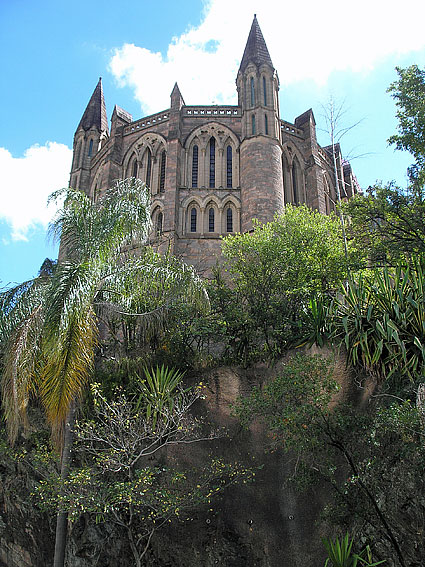
East end of the Cathedral, viewed from below the cliffs in Adelaide Street
[Photograph by Simon Colvin (May 2008)]
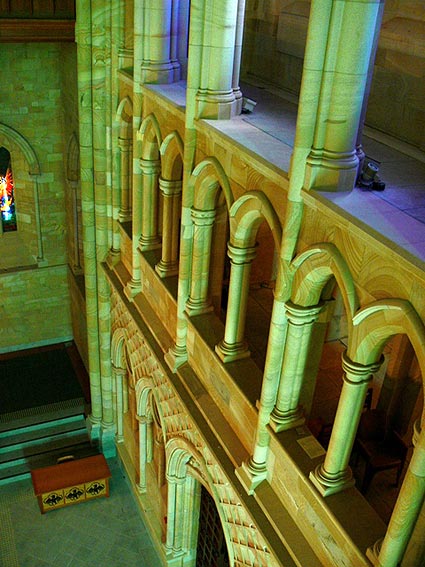
Sandstone arches and triforium passages at the completed west end
[Photograph by John Maidment (October 2007)]
From 1910 until the mid 1960s, the building remained much as it was opened. The east end, comprising the sanctuary, side chapels and transepts, adjoined just two bays of the nave with a temporary west wall.
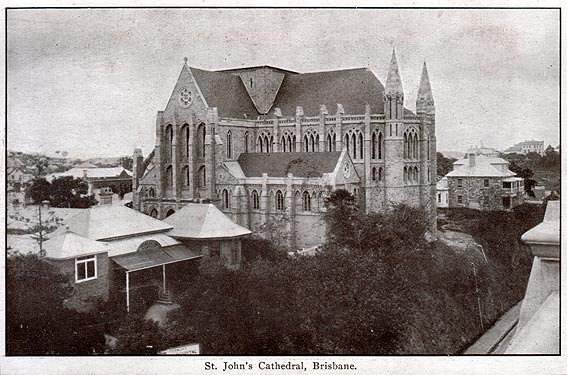
The incomplete St John's Cathedral, c.1911
[Photograph from an undated postcard
in the possession of Simon Colvin]
The second phase of the building, comprising an extension of a further four bays to the nave, was commenced in 1965 and consecrated in 1968 by Archbishop Philip Strong. Again, a temporary west wall was constructed.
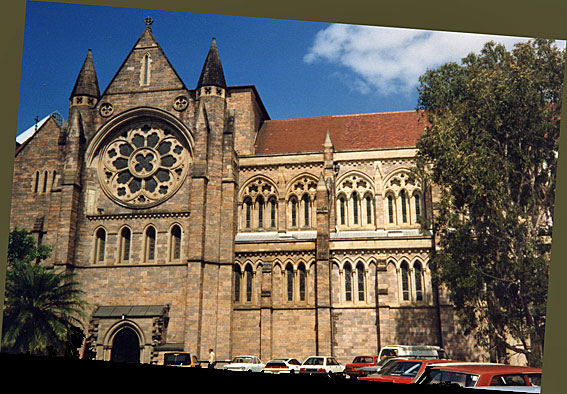
The 1910 building extended in 1968
[Photograph by Howard Baker (September 1989)]
The final phase of construction commenced in 1989, comprising the completion of the nave, construction of the south-west porch and west front, addition of the north and south towers, completion of the central tower, and the addition of the three spires. The completed building was consecrated by Archbishop Phillip Aspinall in October 2009.
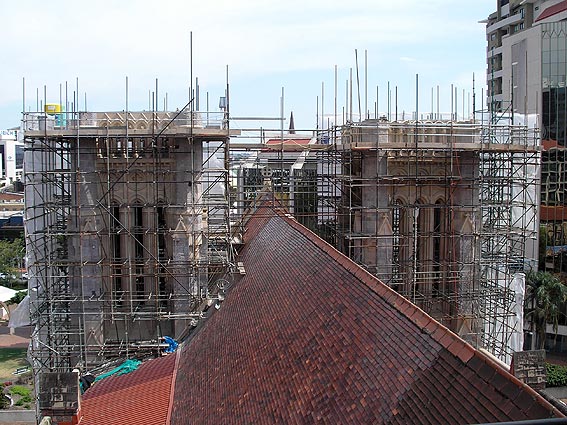
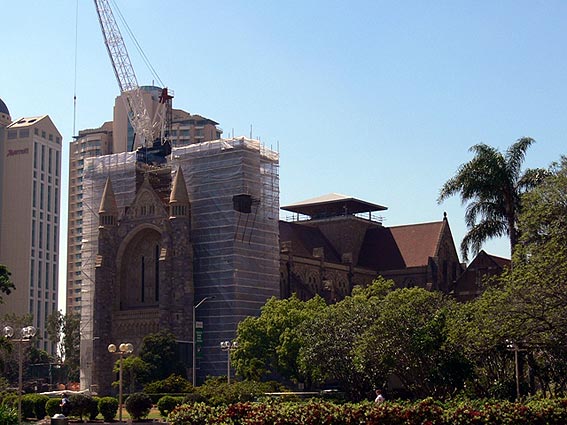
The north and south towers under construction in 2007
[Photographs (1) by Simon Colvin from the central tower,
and (2) by John Maidment (October 2007)]
The surrounding buildings, including the Deanery, Webber House, Church House, and the former St Martin's Hospital, are all of architectural and historical significance.2
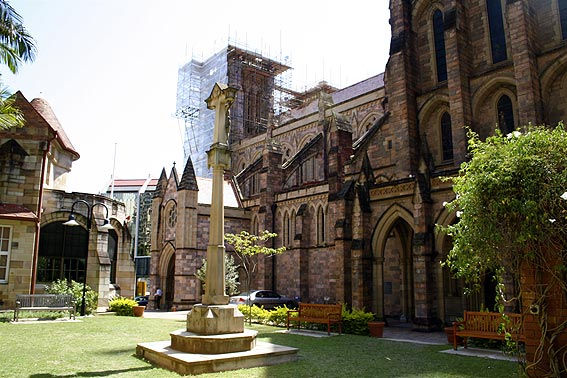
Courtyard between the former St Martin's Hospital and the Cathedral,
with the towers still under construction
[Photograph by Trevor Bunning (October 2007)]
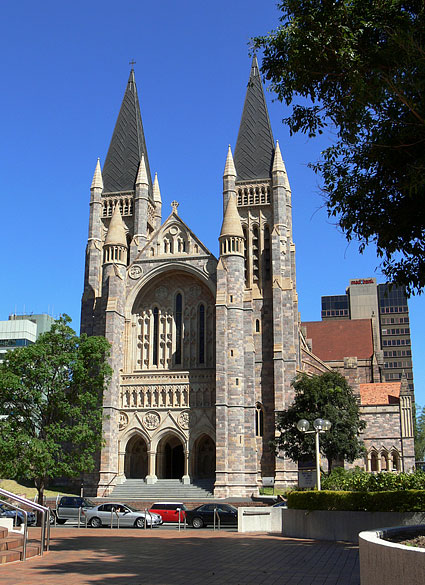
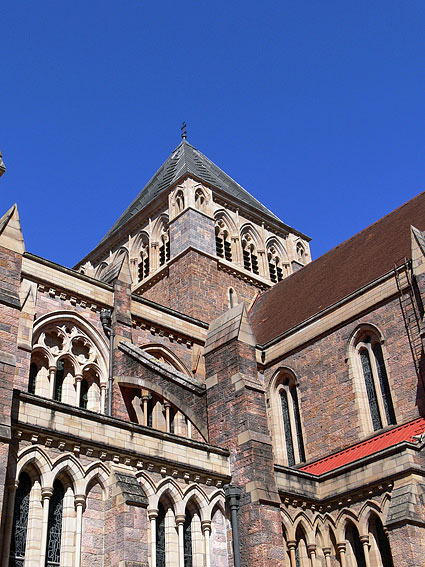
The completed Cathedral in 2009
[Photographs by John Maidment (December 2009)]
Main Organ.
The specification of the organ was announced in The Brisbane Courier on 8 January 1909 as having been drawn up by the organist, Mr George Sampson. It was stated at the same time that the order for 'supplying' the instrument had been entrusted to Messrs. B.B. Whitehouse and Co. of Brisbane, and that it was expected it would be erected in time to be opened in November that year.3
In the event, the organ and the building were not completed until late in 1910. The instrument was built by Messrs. Norman & Beard Ltd, of London and Norwich, in collaboration with the Brisbane firm. It was completed in time for the consecration of the building on Friday 28 October 1910:
The consecration of the Cathedral Church of St. John the Evangelist took place yesterday with imposing ceremonial . . . A fine organ has been installed. The specification of the instrument was prepared by Mr. George Sampson, F.R.C.O., organist of the Cathedral. The organ was built by Messrs. Norman and Beard, of London, in conjunction with Messrs. B. B. Whitehouse and Co., Brisbane, a large portion of the organ being made in Brisbane. The manual pedal, draw stop, and piston action is the latest system of tubular pneumatic, ensuring perfect repetition, whether the manuals are used single or coupled. The console is made according to the revised Royal College of Organists' pattern. The organ is blown by a kinetic electric blower of 10 horse-power, which supplies 2500 cubic feet of wind per minute. The portion of the organ at present erected cost about £2900 and the cost to complete the instrument will be a further £2000.4
The organ was officially opened on Wednesday 30 November 1910, with a recital by George Sampson.5
The records of Messrs Norman & Beard Ltd show that the organ had been ordered in February 1909. The order book records an intended specification of 50 stops, exactly as announced in The Brisbane Courier in January 1909, only 23 of which were supplied in the first instance. Seven of the prepared-for stops (and also couplers) were added between 1912 and 1924, as shown below:
[1924] Space for Space for Space for Space for |
GREAT ORGAN 1. Double Diapason 2. Open Diapason 3. Open Diapason 4. Open Diapason 5. Stopped Diapason 6. Hohl flute 7. Harmonic Flute 8. Principal 9. Fifteenth 10. Mixture 11. Trumpet 12. Clarion |
CC to C 16ft 8ft 8ft 8ft 8ft 8ft 4ft 4ft 2ft 3 ranks 8ft 4ft |
(61 notes) wood throughout 61 pipes metal 61 pipes metal 61 pipes metal 61 pipes wood 61 pipes wood 61 pipes metal 61 pipes metal 61 pipes metal 61 pipes metal 183 pipes metal 61 pipes metal 61 pipes |
Large Extra pressure Medium Extra pressure Small Extra pressure Flute tone Soft Extra pressure Extra pressure |
[1915/1924] Space for Space for Space for Space for Space for [1914] [1912] |
SWELL ORGAN 13. Double Diapason 14. Open Diapason 15. Open Diapason 16. Stopped Diapason 17. Dulciana 18. Vox Angelica 19. Gemshorn 20. Lieblich Flute 21. Fifteenth 22. Mixture 23. Double Bassoon 24. Cornopean 25. Oboe 26. Clarion 27. Vox Humana |
CC to C 16ft 8ft 8ft 8ft 8ft 8ft 4ft 4ft 2ft 3 ranks 16ft 8ft 8ft 4ft 8ft |
(61 notes) wood-metal 61 pipes wood-metal 61 pipes wood-metal 61 pipes wood 61 pipes metal 61 pipes metal 110 pipes metal 61 pipes metal 61 pipes metal 61 pipes metal 183 pipes metal 61 pipes metal 61 pipes metal 61 pipes metal 61 pipes metal 61 pipes |
Small 2 sets of pipes Extra pressure Extra pressure |
Space for Space for Space for Space for Space for Space for [1924] |
CHOIR & SOLO ORGANS 28. Double Diapason 29. Open Diapason 30. 'Cello 31. Dulciana 32. Stopped Diapason 33. Claribel 34. Flauto Traverso 35. Suabe Flute 36. Flautina 37. Viol d'Orchestre 38. Clarinet 39. Orchestral Oboe 40. Tuba |
CC to C 16ft 8ft 8ft 8ft 8ft 4ft 4ft 4ft 2ft 8ft 8ft 8ft 8ft |
(61 notes) wood throughout 61 pipes metal 61 pipes metal 61 pipes metal 61 pipes wood 61 pipes wood 61 pipes metal 61 pipes metal 61 pipes metal 61 pipes metal 61 pipes metal 61 pipes metal 61 pipes metal 61 pipes |
In special Swell box Small Violin tone Extra pressure |
Space for Space for [1924] Space for Space for [1914] Space for |
PEDAL ORGAN 41. Double Diapason 42. Open Diapason 43. Open Diapason 44. Violone 45. Bourdon 46. Principal 47. Bass Flute 48. 'Cello 49. Trombone 50. Posaune |
CCC to F 32ft 16ft 16ft 16ft 16ft 8ft 8ft 8ft 16ft 8ft |
(30 notes) wood 30 notes wood 30 notes metal 30 notes metal 30 notes wood 30 notes wood 30 notes wood 30 notes metal 30 notes metal 30 notes metal 30 notes |
(stopped) Not too small Partly derived from Open Partly derived from Bourdon Partly derived from Violone Partly derived from Trombone |
[1924?] [1924] [1924] |
COUPLERS 51. Swell Octave 52. Swell Sub Octave 53. Swell to Great 54. Swell to Choir 55. Choir to Great 56. Choir to Great Octave 57. Choir to Great Sub Octave 58. Swell to Pedal 59. Great to Pedal 60. Choir to Pedal |
Pneumatic Pneumatic Pneumatic Pneumatic Pneumatic Pneumatic Pneumatic Mechanical Mechanical Mechanical |
|
ACCESSORIES |
(2 prepared for initially) (2 prepared for initially) (2 prepared for initially) (prepared for - 3 later added) |
||
Tremulant to Swell Tubular-pneumatic action throughout A suitable electric motor and Kinetic Blower to be supplied for the first portion of the organ. |
|||
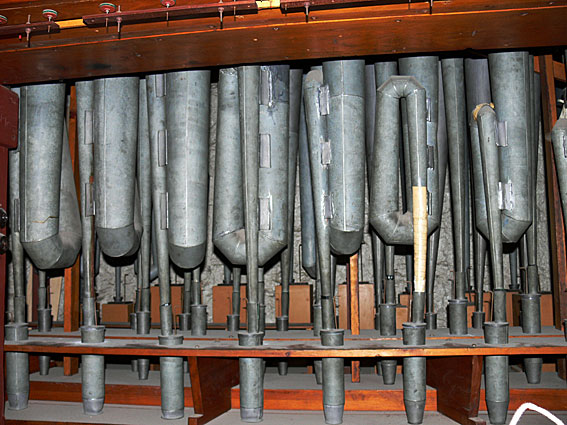
The Pedal Trombone 16ft stop, added in 1914
[Photograph by John Maidment (October 2007)]
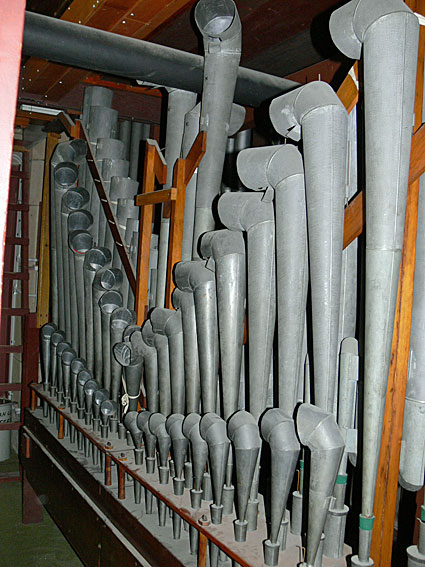
The Tuba 8ft stop, added to the Choir & Solo Organs in 1924
[Photograph by John Maidment (October 2007)]
Details of the additions between 1912 and 1924 were recorded on plaques on the original console, as well as in the records of Norman & Beard and Whitehouse Bros. The Swell Vox Humana 8ft, which left England in September 1912, was donated in memory of Marie Simmons, who was an organist and the wife of The Revd Hugh Simmons. The Pedal Trombone 16ft, which left England in July 1913, was donated by Mrs N. Coungeau in memory of Annie Howard. It was first used at a recital given by George Sampson on 30 March 1914. The Swell Clarion 4ft, which left England in June 1914, was donated in memory of John and Mary Jane Hempsted.7
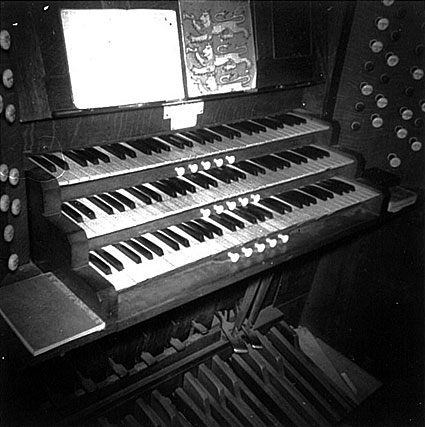
The Norman & Beard console of 1909,
showing vacant plugged holes on the jambs for intended additions
[Photograph by Geoffrey Cox (c.1969)]
Some confusion remains concerning the date of the Swell Double Diapason addition. A stop described in the Norman & Beard records as "Swell 16ft Double Diapason" was shipped from England in June 1915, but it was described as the new "Swell Bourdon stop" presented by Mrs N. Congeau when used at a recital in the Cathedral on Monday 11 October 1915.8 A Swell Bourdon 16ft was also recorded on the old console as one of the 1924 additions, which marked the centenary of the City of Brisbane.
The 1924 additions were carried out by Whitehouse Bros of Brisbane, who obtained the necessary pipework and materials from Hill, Norman & Beard in England. The casework in the north transept was added at the same time. The relevant entry in the Whitehouse Ledger at the time includes "supplying 49 Bourdon pipes to Swell Organ, supplying Tuba 61 pipes, Double Diapason 12 pipes CCC to B, . . . supplying 12 pipes CC to B Double Diapason, 48 Dummy pipes to complete design, . . . supplying Pneumatic Action and tubing for borrowing Double Diapason on pedal organ."9
A letter concerning the Swell Double Diapason from B.B.Whitehouse & Co. to Norman & Beard in 1915 included the statement "We take it that you will use metal as far down as advisable, as the wood pipes are dutiable."10 It appears, therefore, that the upper (metal) registers of the original Swell Double Diapason may have been transferred to the Great as a Double Diapason in 1924, at which time both stops were completed. The Pedal Violone added in 1924 was borrowed from the Great Double Diapason, although this had not been the original intention. Pipes for these two stops are contained in the north-transept casework.
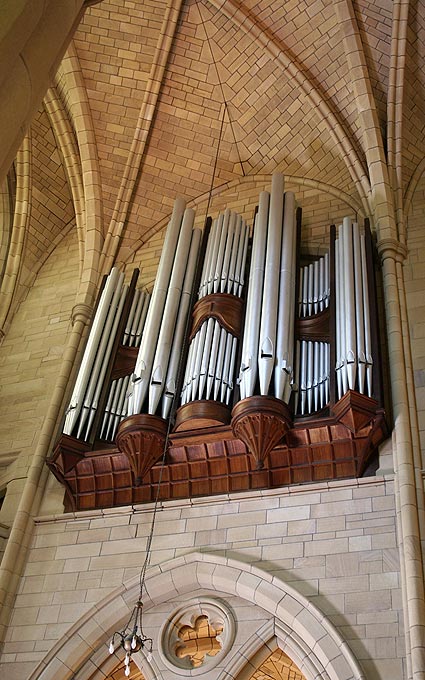
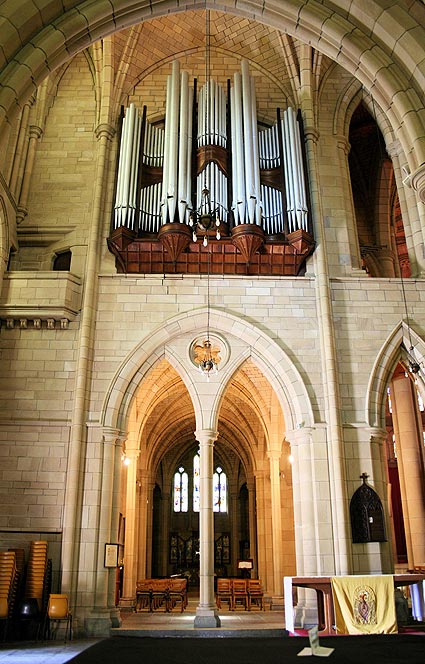
Casework in the north transept,
added in 1924 as a gift of the City of Brisbane
[Photographs by Trevor Bunning (October 2007)]
Relatively recently, Denzil Scrivens has brought to light Frank Pearson's designs for the casework, both for the transept and the sanctuary façades. These reveal that the casework added in the north transept in 1924 followed Pearson's design, although it was only partially completed at the time. The transept case included Pearson's intended four towers and most of the base, but lacked the decorative carved pipeshades and canopies. Pearson's design for the sanctuary case was similarly decorative, including three towers for both the upper section and a 'positiv' section below, but none of this was ever built. The spacing of the pipes in the upper section neverthelsss appears to have allowed for Pearson's casework to be added.11
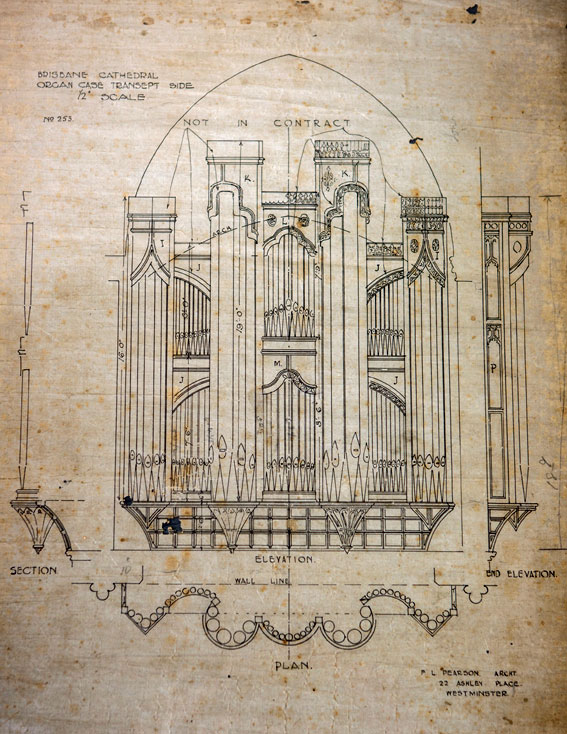
Frank Pearson's design for the transept organ case
(Kirsty McPhee: St John's Cathedral Archives)
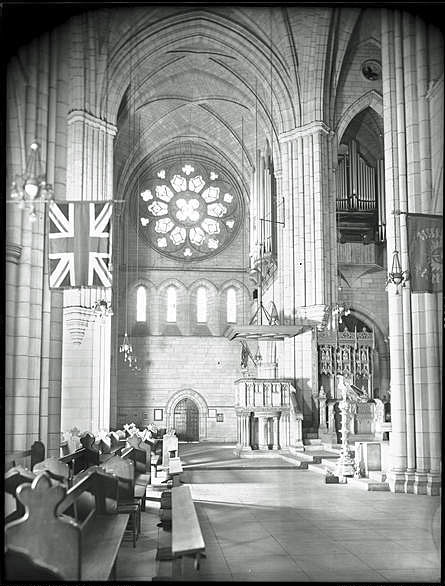
The north transept before 1962,
showing the organ console at floor level in the organ chamber
and the original configuration of the Great Organ façade pipes
[Photograph by Frank Hurley, 1885-1962, from the Hurley negative collection,
National Library of Australia (http://nla.gov.au/nla.pic-an23208845)]
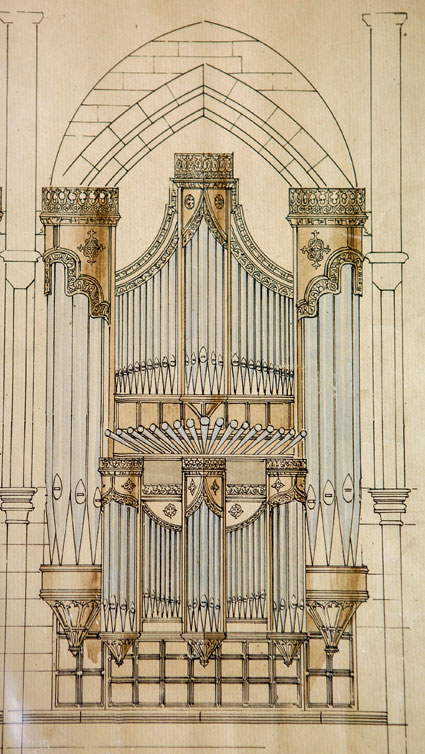
Frank Pearson's design for the sanctuary organ case
[Kirsty McPhee: St John's Cathedral Archives]
It is significant that George Sampson, the cathedral organist, was directly involved in specifying details of voicing of the organ. His instructions to the builder in 1908 included the following:
I shall be glad if you will bear in mind the following points which I consider very important:-
(A) The whole scheme of the organ to be full cathedral scale and designed for a large and lofty building.
(B) The Diapason work to be especially full and mellow. Stops 2 and 3 on Great are too often of much too equal strength.
(C) All these stops Great Nos 8, 9, 10, Swell 21, 22, Choir 36, are in most English organs of far too rasping and harsh a character. I shall be delighted if you can get the same strength without the usual piercing harshness.
(D) Swell Box. . . . I trust that I shall get an absolute PPP when closed on both Swell and Choir . . .
(E) The Pedal Bourdon to be soft enough quality to accompany the softest stops in the Swell.
(F) The Open Diapason wood cannot be too full or weighty.
(G) The tremulant. Messrs. Whitehouse will write regarding this.
(I) Reeds. The quality of the reeds must not be too smooth. On all except the Oboe I want Trumpet tone not Horn or Cornet tone.
(J) Lever Pedal to Swell and Choir.
(K) Time. The New Cathedral is to be opened in November 1909. If possible we should like the organ. . . 12
Following the enlargement of the building in the 1960s, the organ was extensively rebuilt and enlarged between 1970 and 1972 by Messrs Hill, Norman & Beard (Australia) Pty Ltd, in consultation with Robert Boughen,13 organist of the Cathedral from 1960 to 2004. The old instrument was heard for the last time on 15 February 1970.14
The new console, on which the builder's plate gives the date 1971, arrived from Melbourne well before the organ was completed and opened. It sat for a time alongside the old console (1909) on the floor of the Cathedral.15
It is a matter of peripheral interest that the pedalboard from the 1909 Norman & Beard instrument was re-used in 1993 by Simon Pierce for his organ at St George’s Anglican Church, Tamborine Mountain.
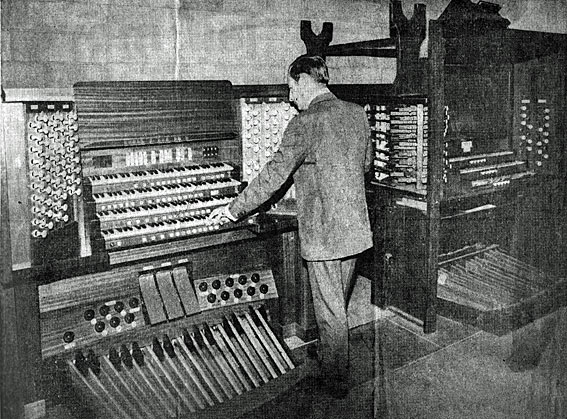
The old (1909) and new (1972) consoles on the floor of the Cathedral
with Robert Boughen, organist
[undated newspaper clipping, late 1971 or early 1972]
The enlarged and rebuilt organ was officially dedicated on Sunday 18 June 1972. With the addition of a Positiv Organ in the former location of the organ console, a swallows nest was extended out below the organ chamber and above the ambulatory to accommodate the new console. The outer towers of the sanctuary façade were raised significantly to accommodate the new Positiv Organ and to allow access to the lowered console.
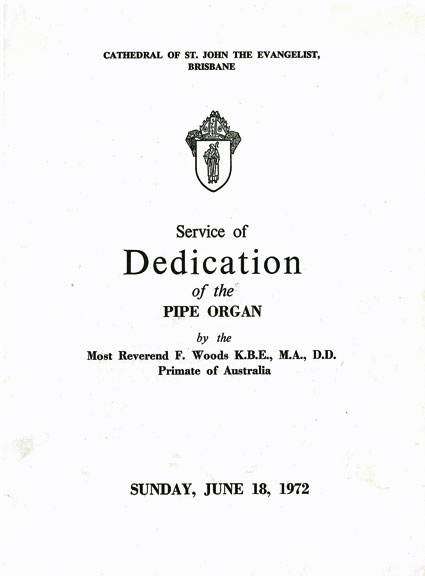
The Order of Service for the re-dedication
of the organ in June 1972
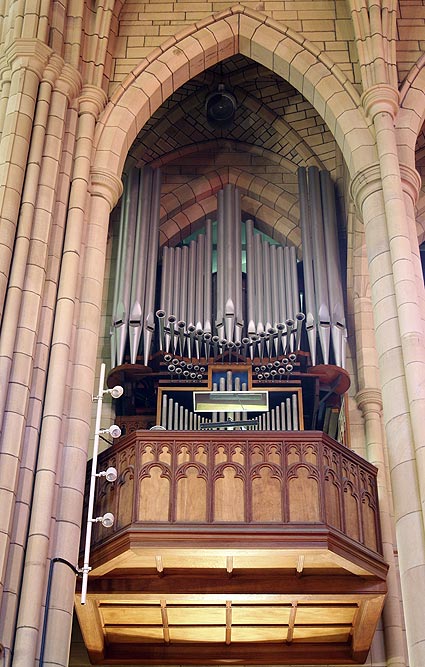
The swallows nest for the new console in 1972
with Positiv Organ and re-arranged façade pipes of the Great Organ above
[Photograph by Trevor Bunning (October 2007)]
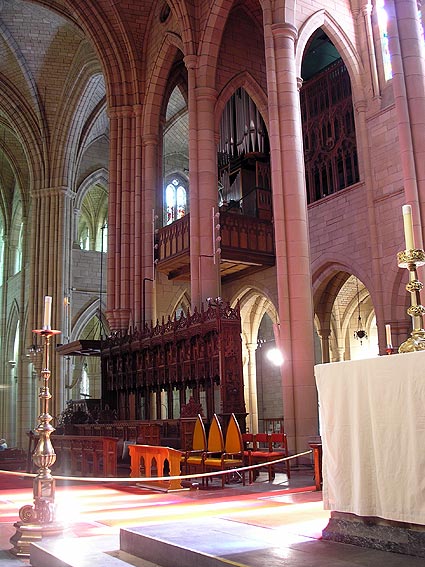
View of the organ from the sanctuary
[Photograph by Simon Colvin (October 2007)]
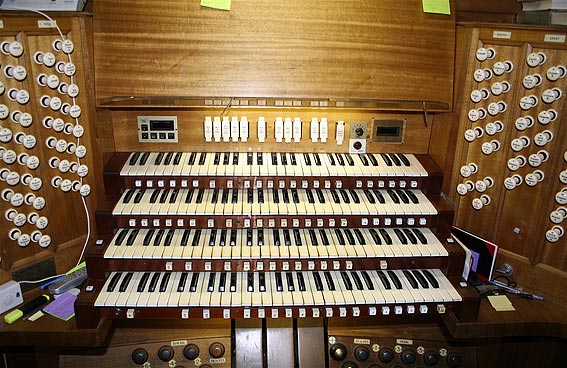
The Hill, Norman & Beard console of 1972
[Photograph by Trevor Bunning (October 2007)]
The conceptual framework for rebuilding the organ in 1970-72 was that of providing a versatile instrument capable of playing repertoire from a variety of schools and periods. At that time in Brisbane, there were no modern mechanical-action organs, and the imperatives followed were those evident in major rebuilds elsewhere by Hill, Norman & Beard. Much of the original pipework was revoiced, and wind pressures were generally lowered. The former Great Open Diapason No 1 was redeployed on the Pedal Organ, the former Great Principal 4ft and Fifteenth 2ft were replaced by new stops, and several stops were moved between divisions. The two 8ft string stops on the Solo Organ were reported to have come from the organ of Gloucester Cathedral in England, which was rebuilt around the same time.16 If the report is correct, they had been added to the Gloucester organ in 1920 by Harrison & Harrison,17 but Simon Pierce has noted that the string stops on the Solo Organ in Brisbane are of composite pipework, possibly incorporating some pipes from the original Swell Dulciana.
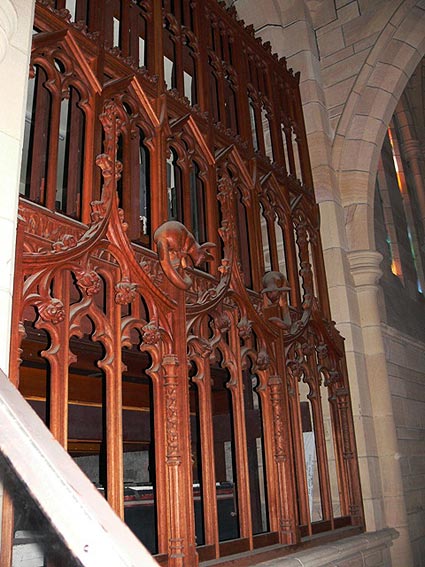
Intricately carved wooden screen by Colin Blumson,
added in front of the Swell Organ in the mid 1970s
and matching the carving in the choir stalls
[Photograph by John Maidment (October 2007)]
The specification of 1972 was as follows:
| GREAT Double Diapason Open Diapason Gemshorn Stopped Diapason Octave Spitz Flute Twelfth Fifteenth Seventeenth Furniture Mounted Cornet Trumpet Clarion |
16 8 8 8 4 4 2-2/3 2 1-3/5 IV V 8 4 |
A |
| SWELL Quintaton Open Diapason Spitz Flute Viola da Gamba Voix Célestes Principal Stopped Flute Fifteenth Full Mixture Sharp Mixture Double Trumpet Cornopean Clarion Oboe Vox Humana |
16 8 8 8 8 4 4 2 III III 16 8 4 8 8 |
F G |
| CHOIR Contra Salicional Open Diapason Bourdon Dulciana Prestant Flute Ouverte Nazard Quarte Tierce Plein Jeu Cromorne Trompette Tuba |
16 8 8 8 4 4 2-2/3 2 1-3/5 III 8 8 8 |
[enclosed] B C D |
| SOLO Flute Harmonique Quintade Viole d'Orchestre Viole Céleste Concert Flute Octave Viol Piccolo Rohr Schalmei Spanish Trumpet Tuba Octave Tuba |
8 8 8 8 4 4 2 8 8 8 4 |
[enclosed except Tuba & Spanish Trumpet] H D D |
POSITIV |
8 4 4 2 2 1-1/3 1 III 8 |
(floating) E |
| PEDAL Acoustic Bass Open Wood Principal Violone Bourdon Quintaten Salicional Octave Bass Flute Choral Bass Spitz Flute Nachthorn Mixture Contra Posaune Trombone Trumpet Tromba Trompette Krummhorn Rohr Schalmei |
32 16 16 16 16 16 16 8 8 4 4 2 IV 32 16 16 8 8 8 4 |
A I F B I J G J C E H |
COUPLERS
Solo to Pedal
Swell to Pedal
Swell Octave to Pedal
Great to Pedal
Choir to Pedal
Solo to Swell
Solo to Great
Swell to Great
Choir to Great
Solo to Choir
Swell to Choir
Positiv to Solo
Positiv to Great
Positiv to Choir
Positiv to Pedal
Swell Octave
Swell Sub Octave
Swell Unison Off
Solo Octave
Solo Sub Octave
Solo Unison Off
Choir Octave
Choir Sub Octave
Choir Unison Off
Swell tremulant
Choir tremulant
Positiv tremulant
Solo tremulant
Piston Coupler Great & Pedal
8 combination pistons to Great Organ
8 combination pistons to Swell Organ
8 combination pistons to Choir Organ
8 combination pistons to Solo Organ
4 combination pistons to Positiv Organ
8 combination pistons to Pedal Organ
6 General combination pistons
Full Organ
General Cancel
Compass: 61/32
Electro-pneumatic action throughout, except for Positiv and Solo (direct electric action).18
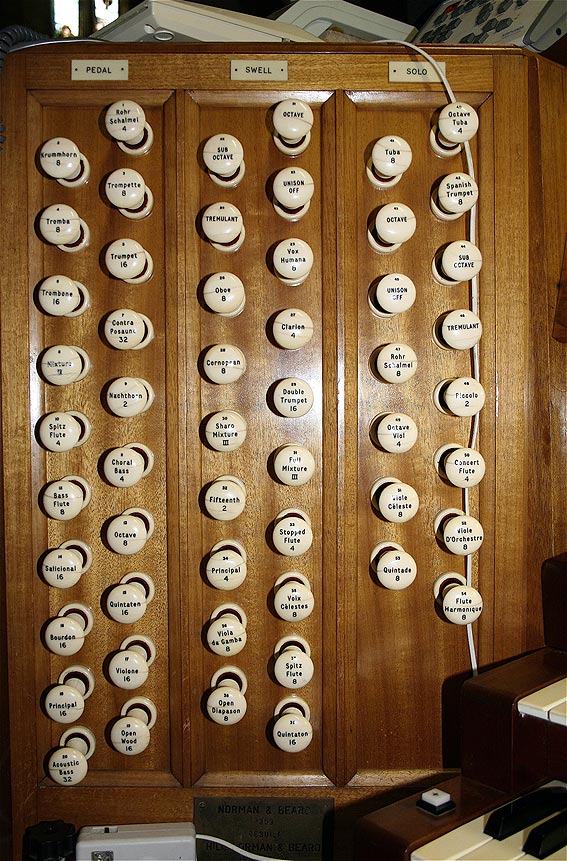
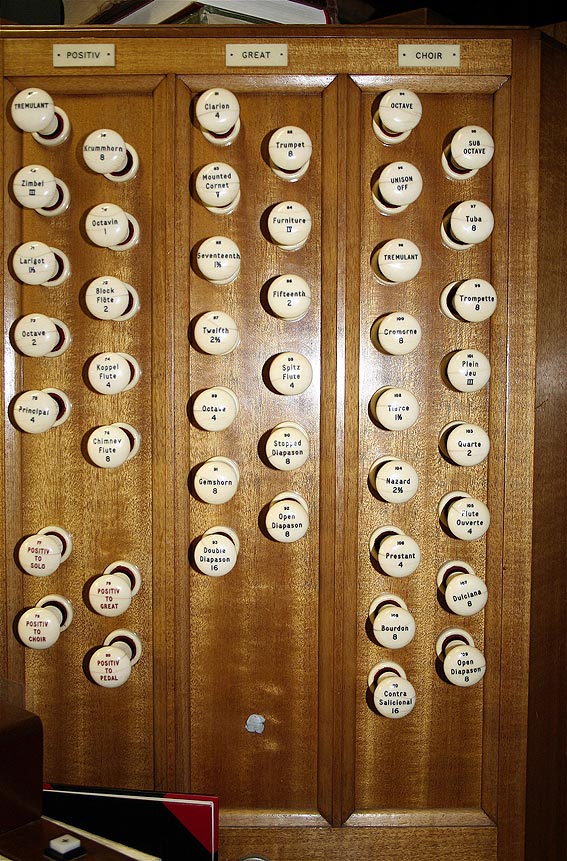
Left and right stop jambs on the 1972 console
[Photographs by Trevor Bunning (October 2007)]
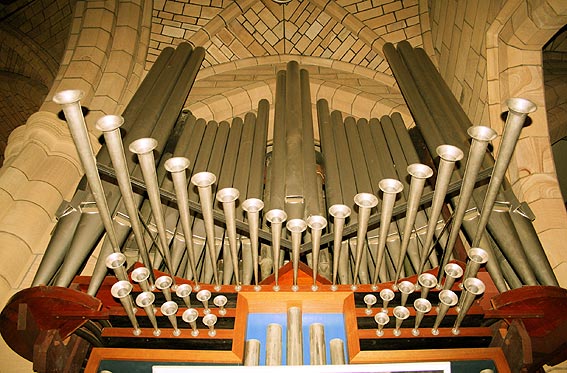
Spanish Trumpet 8ft, added to the Solo Organ in 1972
[Photograph by Trevor Bunning (October 2007)]
Following the re-opening of the organ in 1972, recital series by Robert Boughen at the Cathedral included the complete organ works of Bach (twice), Messiaen, Buxtehude, Brahms, Franck, Howells, Liszt, Mozart and Mendelssohn.19 The rebuilt instrument served from this time to inspire several generations of young organists who had not otherwise had the opportunity to perform the wide repertoire of the organ on such a versatile instrument.
Some of the changes effected in 1972 were already being questioned by the early 1990s, when the wind system of the organ was overhauled and the wind pressure of the Tuba was re-set to 16 inches by W.J. Simon Pierce of Brisbane.20 Around 2005-06, W.J. Simon Pierce returned the original Principal 4ft and Fifteenth 2ft to the Great Organ, these having spent a period in exile at St Augustine's Anglican Church, Hamilton.21
With the completion and enlargement of the Cathedral, the instrument was found to lack the necessary projection of sound. Under the direction of Rev. Rupert Jeffcoat (organist of the Cathedral from 2005 to 2010), Simon Pierce sought to restore something of the character of the 1909 instrument, whilst working within the general scope of the 1972 specification. Wind pressures were generally raised, existing pipework was revoiced to suit the higher pressures, and some stops that had been moved between divisions in 1972 were returned to their original location.22 Four of the 1972 stops (Gt. Gemshorn 8ft; Gt. Spitz Flute 4ft; Sw. Spitz Flute 8ft; Ch. Trompette 8ft), were deleted to make way for five new stops (as listed below) that better serve the restored 1909 character of the organ.
The entire work was reported to have been completed late in 2010.23 The revised specification, as noted in July 2011, is as follows:
| GREAT Double Diapason Open Diapason No. 1 Open Diapason No. 2 Clarabella Principal Harmonic Flute Twelfth Fifteenth Seventeenth Mixture Mounted Cornet Double Trumpet Trumpet Clarion |
16 8 8 8 4 4 2-2/3 2 1-3/5 III V 16 8 4 |
A G |
[1915/1924] [2010, but incorporating 12 façade pipes of 1909] [1909 Open Diapason No. 3] [2010] [1909; returned c.2006] [1909; returned from Solo] [1972] [1909; returned c.2006] [1972] [1972; top rank removed 2010] [1972] [1972; formerly on Swell] [1909 (bass) + 2010 (from Tenor G)] [1972] |
| SWELL Bourdon Open Diapason Stopped Diapason Viola da Gamba Voix Célestes Principal Stopped Flute Fifteenth Full Mixture Sharp Mixture Bassoon Cornopean Clarion Oboe Vox Humana |
16 8 8 8 8 4 4 2 III III 16 8 4 8 8 |
F |
[1924; revoiced 1972 as Quintaton] [1909] [1909; returned from Great] [1972] [1972] [1909 Gemshorn] [1972] [1909] [1972] [1972] [2010] [1909] [1914] [1909] [1912] |
| CHOIR [enclosed] Contra Salicional Open Diapason Bourdon Dulciana Prestant Flute Ouverte Nazard Quarte Tierce Plein Jeu Clarinet Trompette Tuba |
16 8 8 8 4 4 2-2/3 2 1-3/5 III 8 8 8 |
B C D |
[1972] [1909] [1909 Stopped Diapason] [1909] [1972] [1909 Suabe Flute] [1972] [1909 Flautina] [1972] [1972] [1909 Clarinet; renamed & revoiced Cromorne 1972] [1972 Gt Trumpet (from Tenor G) + 1972 Ch Trompette (bass)] [1924] |
| SOLO Flute Harmonique Quintade Viole d'Orchestre Viole Céleste Concert Flute Octave Viol Piccolo Rohr Schalmei Spanish Trumpet Tuba Octave Tuba |
8 8 8 8 4 4 2 8 8 8 4 |
H D D |
[enclosed except Tuba & Spanish Trumpet] [1972 Concert Flute 4] [1972] [1972] [1972] [2010] [1972] [1972] [1972] [1972] [1924] [1924; extended 1972] |
| POSITIV [floating] Chimney Flute Principal Koppel Flute Octave Block Flote Larigot Octavin Zimbel Krummhorn |
8 4 4 2 2 1-1/3 1 III 8 |
E |
[1972] [1972] [1972] [1972] [1972] [1972] [1972] [1972] [1972] |
| PEDAL Acoustic Bass Open Wood Principal Violone Bourdon Echo Bourdon Salicional Octave Bass Flute Choral Bass Spitz Flute Nachthorn Mixture Contra Posaune Trombone Trumpet Tromba Trompette Krummhorn Rohr Schalmei |
32 16 16 16 16 16 16 8 8 4 4 2 IV 32 16 16 8 8 8 4 |
|
[1972] [1909] [1972] [1915/1924] [1909] [1924; revoiced 1972 as Quintaten] [1972] [1972] [1909] [1972] [1972] [1972] [1972] [1972] [1914] [1972] [1914/1972] [1972] [1972] [1972] |
COUPLERS
Solo to Pedal
Swell to Pedal
Swell Octave to Pedal
Great to Pedal
Choir to Pedal
Solo to Swell
Solo to Great
Swell to Great
Choir to Great
Solo to Choir
Swell to Choir
[Positiv to Solo] [deleted, but to be returned]
Positiv to Great
Positiv to Choir
Positiv to Pedal
Swell Octave
Swell Sub Octave
Swell Unison Off
Solo Octave
Solo Sub Octave
Solo Unison Off
Choir Octave
Choir Sub Octave
Choir Unison Off
Swell tremulant
Choir tremulant
Positiv tremulant
Solo tremulant
Piston Coupler Great & Pedal
8 combination pistons to Great Organ
8 combination pistons to Swell Organ
8 combination pistons to Choir Organ
8 combination pistons to Solo Organ
4 combination pistons to Positiv Organ
8 combination pistons to Pedal Organ
24 General combination pistons
Full Organ
General Cancel
Compass: 61/32
Electro-pneumatic action throughout, except for Positiv and Solo (direct electric action).24
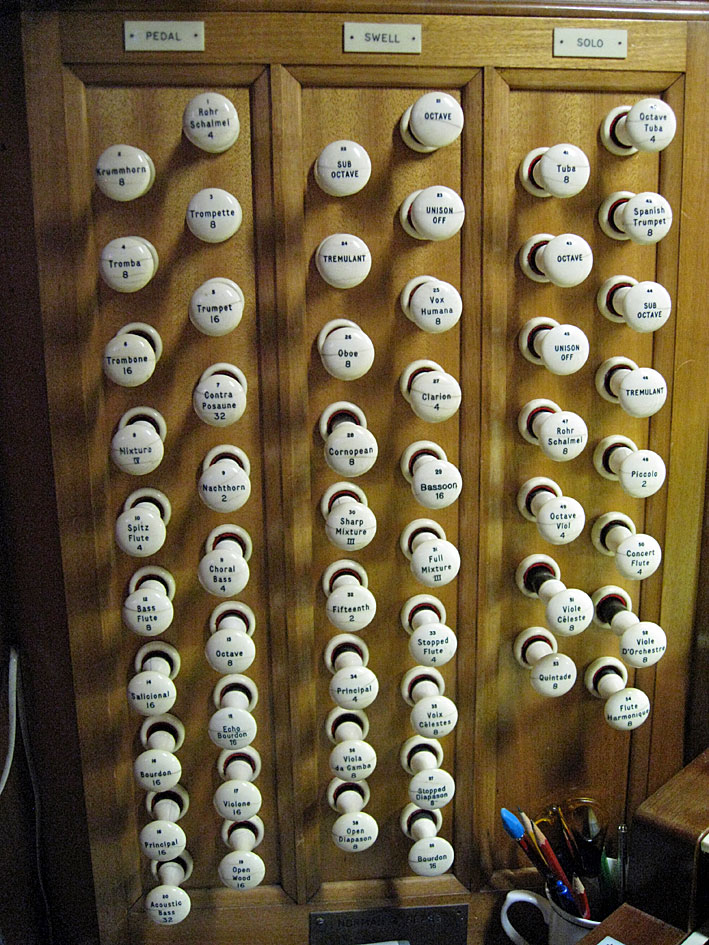
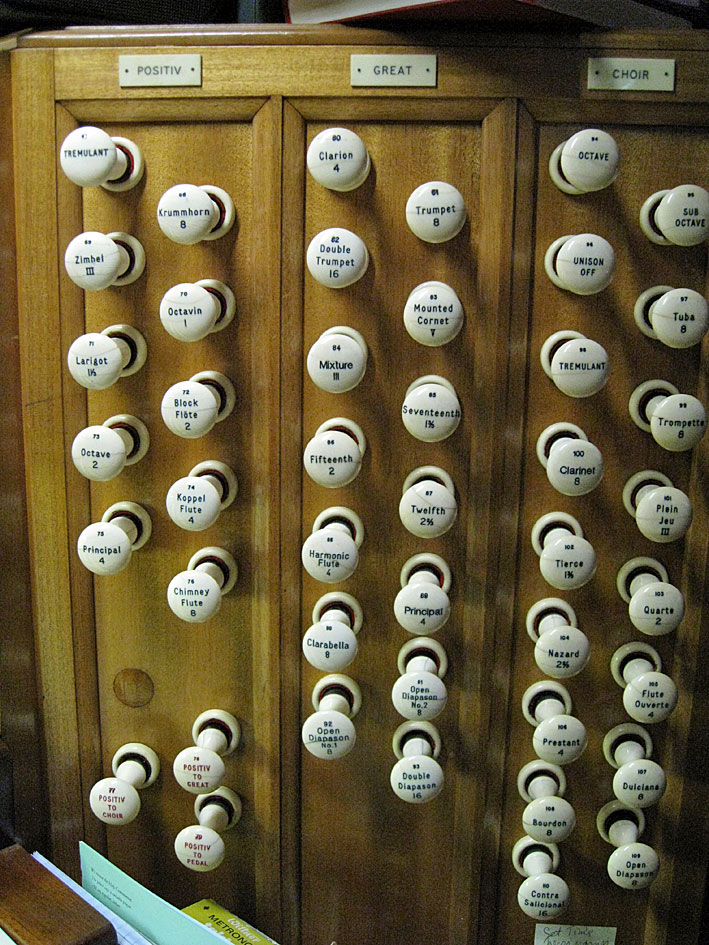
The revised specification as seen on the stop-jambs
[Photographs by Geoffrey Cox (July 2011)]
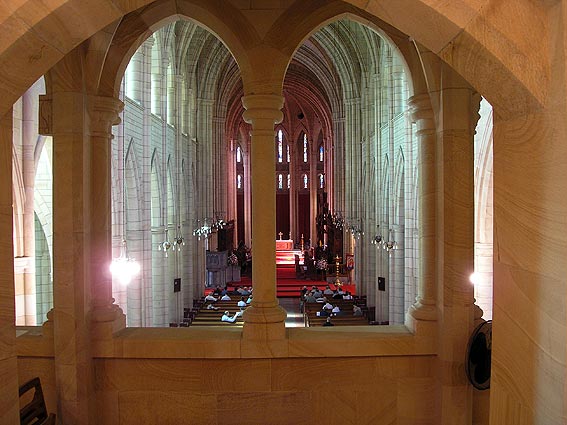
The nave viewed from the triforium passages at the west end
[Photograph by Simon Colvin (October 2007)]
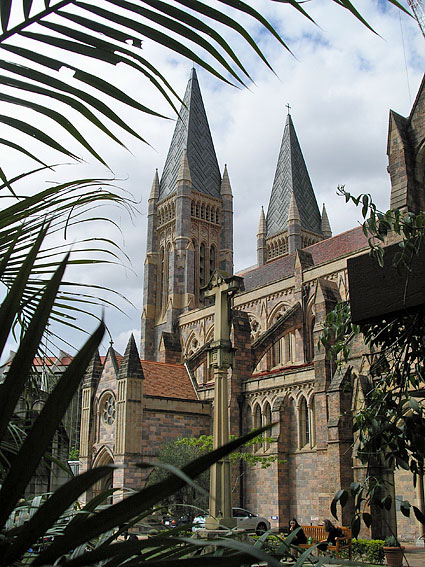
[Photograph by Simon Colvin (January 2009)]
The organ suffered water damage during a freak storm on 27 November 2014.25 A small two-manual Laukhuff organ, originally located at St James' Anglican Church, Kelvin Grove, was installed in the Cathedral in 2016 on a temporary basis, pending repairs to the main organ.
Chamber Organ.
The chamber organ, made by Pierce Pipe Organs of Brisbane, was completed and installed in March 2019. The instrument was gifted to the Cathedral by the Brisbane Chamber Choir (Director: Graeme Morton), who perform most of their concerts in the Cathedral.26
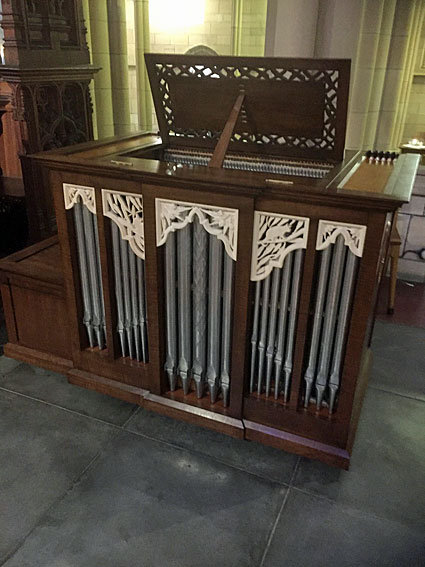

Chamber organ by Pierce Pipe Organs of Brisbane
[Photographs by Geoffrey Cox (July 2019)]
The casework of Tasmanian Oak, made by Derek Smart, incorporates pipe shades and decorative panels of Silver Ash. The pipe shades were designed by Imogen Pierce, featuring native flora and fauna reflecting aspects of Colin Blumsden’s screen on the main organ.
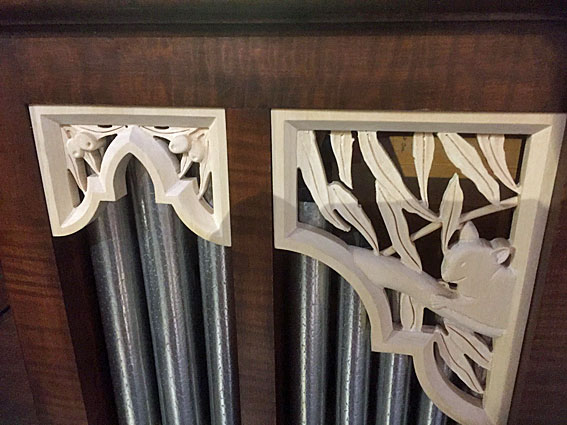
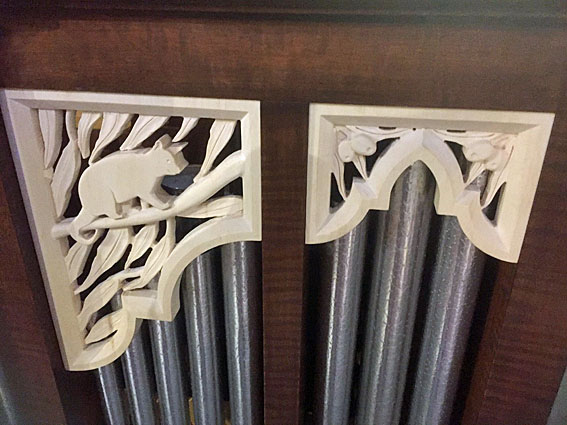
Pipeshades designed by Imogen Pierce
[Photographs by Geoffrey Cox (July 2019)]
The soundboards and pipe shades were created with the aid of a CNC machine, operated by Lachlan and Imogen Pierce. The pipework, by Tim Gilley of Melbourne, includes a spotted-metal façade with a decoratively embossed central pipe.
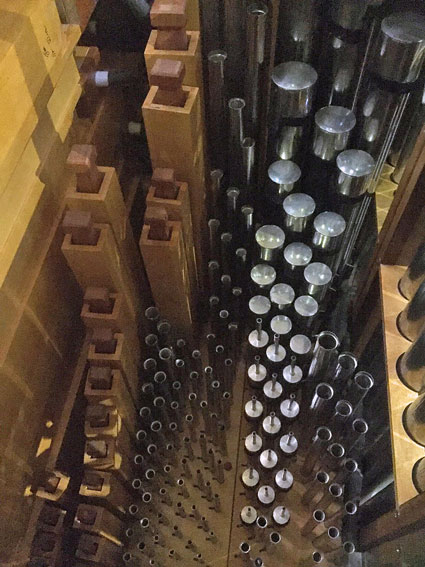
Pipework of the chamber organ
[Photograph by Geoffrey Cox (July 2019)]
| Manual Stopt Diapason Principal Chimney Flute Fifteenth Mixture |
8 4 4 2 II |
Mechanical action
Compass: 56 notes
Transposing mechanism (440/415).27
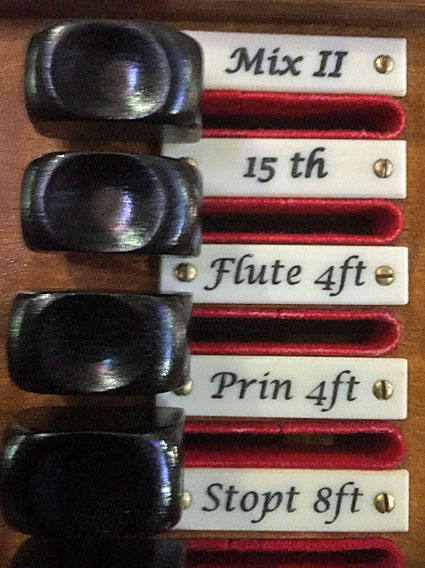
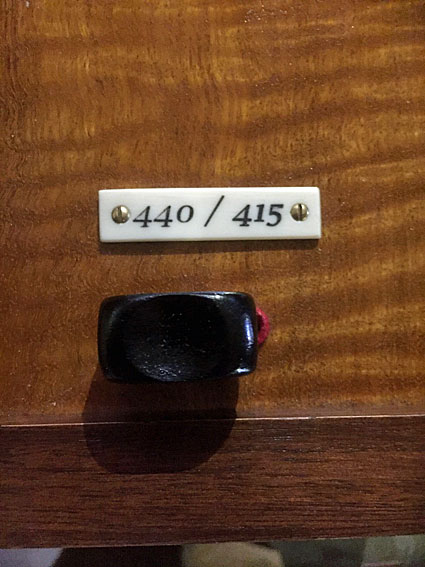
Stops and transposition control
[Photographs by Geoffrey Cox (July 2019)]
______________________________________________________________________________
1 J. Donald Bleakley, Guide to St John's Cathedral, Brisbane (Brisbane, 1969).
2 Queensland Heritage Council, Queensland Heritage Register, location 600076; The Heritage of Australia: The Illustrated Register of the National Estate (South Melbourne: Macmillan, 1981), 4/12.
3 The Brisbane Courier (8 January 1909), p. 5.
4 The Brisbane Courier (29 October 1910), pp. 5, 6; The Queenslander (31 October 1910), p. 37.
5 The Brisbane Courier (30 November 1910), p. 2.
6 Specification for Order Number 999 in Norman & Beard Order Book (3 February 1909), supplied by S. Forder (Director and Secretary, Hill Norman & Beard, London) to Geoffrey Cox, 1974. Details of additions [in square brackets] noted at the old console agree substantially with those given in George Sampson, 'The Music at St. John's Cathedral from 1898 to 1935,' Brisbane Cathedral Notes, vol. 19, no. 242 (1 Oct 1935), pp. 133-34, although Sampson states that only 19 stops remained to be added, and does not list the Choir/Solo Orchestral Oboe as 'still required'.
7 Details from plaques on the original console, noted by G. Cox, c.1972; Details of Norman & Beard invoices 11715, 12065 and 12572 to Messrs B.B.Whitehouse & Co., supplied by S. Forder (Director and Secretary, Hill Norman & Beard, London) to Geoffrey Cox, 1974; Brisbane Cathedral Notes, cited by Robert Boughen, c.1974; The Brisbane Courier (1 March 1913), p. 16.
8 Norman & Beard Invoice 12990 to Messrs B.B.Whitehouse & Co. (21 June 1915), supplied by S. Forder (Director and Secretary, Hill Norman & Beard, London) to Geoffrey Cox, 1974; Brisbane Cathedral Notes, cited by Robert Boughen, c.1974.
9 Whitehouse Bros Ledger (1922-1940), p. 79.
10 Letter dated 30 April 1915 from B.B. Whitehouse & Co. to Norman & Beard, supplied by S. Forder (Director and Secretary, Hill Norman & Beard, London) to Geoffrey Cox, 1974.
11 Denzil Scrivens, 'The Organ of St John's Cathedral, Brisbane: The Rediscovery of the Organ Case Designs,' OHTA News, vol. 40, no. 3 (July 2016), pp. 16-23.
12 Letter dated 26 December 1908 from George Sampson to Norman & Beard, supplied by S. Forder (Director and Secretary, Hill Norman & Beard, London) to Geoffrey Cox, 1974.
13 Hill, Norman & Beard Order nos Q793, 867 & 877, noted in OHTA News, vol. 14, no. 2 (April 1990), pp. 27, 29.
14 Date supplied by Dr R.K. Boughen (Cathedral Organist 1960-2004) in personal communication to G. Cox, November 2004.
15 Undated newspaper clipping, late 1971 or early 1972, supplied by John Maidment.
16 S.J. Webb, 'The rebuilt Gloucester Organ,' The Musical Times, vol. 112 (1971), p. 799.
17 The Organs and Organists of Gloucester Cathedral (Friends of Gloucester Cathedral, c.1972), pp. 17-19.
18 Specification noted by G. Cox, 1972.
19 Biographical notes provided for a recital at Brisbane City Hall during the 30th Annual Conference of OHTA (30 September 2007).
20 The Organ Voice, vol. 19, no. 3 (December 1991), p. 56.
21 Personal communication to G. Cox from W.J. Simon Pierce, August 2008.
22 Interim reports were provided in OHTA News, vol. 33, no. 1 (January 2009), p. 10, and in Organ Australia, vol. 5, no. 3 (September 2009), pp. 8-9.
23 David Vann, 'An Organ Ramble to St John's Cathedral, Brisbane,' Organ Australia, vol. 7, no. 1 (January 2011), pp. 14-17.
24 Specification noted by Geoffrey Cox, July 2011, with details of changes provided by Simon Pierce.
25 Personal communication to G. Cox from Simon Pierce, November 2014.
26 Personal communication to G. Cox from Graeme Morton, July 2019.
27 Specification and other details noted by Geoffrey Cox and from the facebook page of Pierce Pipe Organs, July 2019.